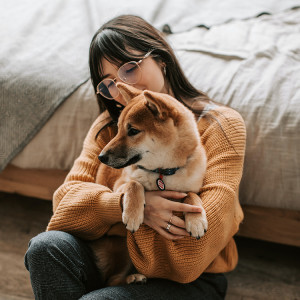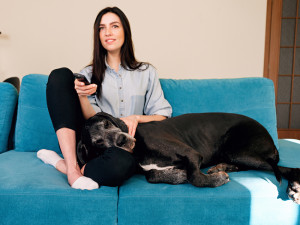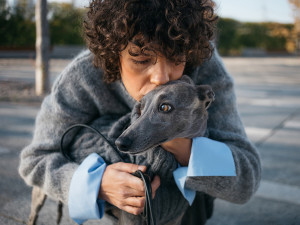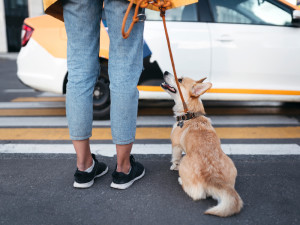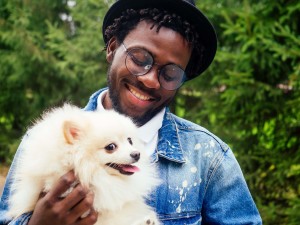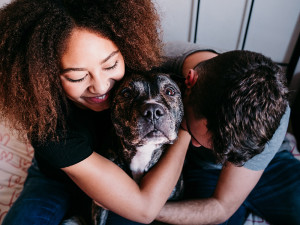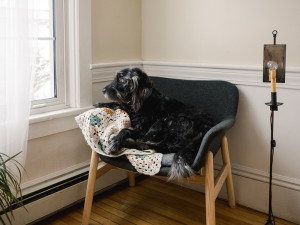8 Things We Do That Really Confuse Our Dogs
Why your dog freaks out when you give someone a hug — and other human behaviors they just don’t understand.

share article

Your pet wants you to read our newsletter. (Then give them a treat.)
Dogs are extraordinarily flexible creatures — how else could they live in our homes with us, learn to walk on a leashopens in a new tab, and tag along on road tripsopens in a new tab? That said, there are a few ways that evolution hasn’t equipped pups for the challenges of living in our world. From watching TV to hugging, here are some of the things we do that dogs just don’t understand.
1. We leave them alone
As born socialites, dogs make friends easily. Puppies are intensely interested in spending time with other dogs, people, and any species willing to interact with them socially. They usually play, restopens in a new tab, explore, and travelopens in a new tab with company. Yet we often leave dogs alone: at home, in kennels, or at the vet. Young dogs can’t be sure we’ll ever return to get them. Only after experience are they likely to expect a reunion, and even then, their experience depends on the context.
At home, we may try to enforce dog-free zones. Naturally, many dogs protest. How can they stay with their (human) social group when they’re separated behind impenetrable barriers (doors)? This explains why dogs so often demand to be let inside when their human family is there, and why those with separation-relatedopens in a new tab distress frequently find some solace in being indoors.
2. We watch TV
Dogs live in an olfactory world, while ours is chiefly visual. So, while TVs may offer a visual feast for humans, parks and beaches are an olfactory banquet for dogs. An additional challenge is dogs move while investigating the world, whereas we often sit still. They may not relish the inertia we enjoy in front of a noisy, flashing light-box.
3. We change our smell and shape
Shoes, coats, wallets, briefcases, bags, and suitcases: countless smells cling to these items after we take them into shops and workplaces, then back to our dogs. Cleaning products, soaps, deodorants, and shampoos also change the scents our dogs are used to.
Towels, hats, and bags change our shape when we’re using them. And when we’re pulling them on, jumpers and coats alter our visual outline and may catch dogs off-guard. Dogs change their coats at least once a year. In contrast, we change our external wear every day. This means the odors we carry are changing far more than dogs have evolved to expect. In their olfactory world, it must be puzzling for dogs to encounter our constantly changing smells, especially for a species that uses scent to identify familiar individuals and intruders.
4. We like to hug
How humans use their forelimbs contrasts sharply with how dogs do. We may use them to carry large objects a dog would have to drag, but also to grasp each other and express affection. Dogs grasp each other loosely when play-wrestling, and also when mating and fighting. Being pinned by another dog prevents a quick escape. How are puppies to know what a hug from a human means, when that behavior from a dog might be threatening?
5. We don’t like to be bitten
Play-fighting is fun for many puppies and helps them bond with other dogs. But they must monitor the behavior of other dogs in play-fights and know when they’ve used their tiny, razor-sharp teeth excessively. Humans are much more susceptible to pain from playful puppy jaws than other dogs are, and so we may react negatively to their attempts to play-fight with us.
Dogs interact with objects almost entirely with their muzzle. And to feed, they use their jaws, teeth, and tongue. Dogs also “mouth” other dogs when playing, expressing affection and communicating everything from “more” to “please don’t” to “Back off!” So, naturally, they try to use their mouths when communicating with us and must be puzzled by how often we take offense.
6. We don’t eat food from the trash
Dogs are opportunists who naturally acquire food anywhere they find it. In contrast, we present them with food in dishes of their own. Puppies must be puzzled by our reaction when we find them snacking from benches and tables, in lunchboxes, and kitchen trash cans. We shouldn’t be surprised when dogs unearth food we left somewhere accessible to them.
7. We share territories
We visit the territories of other dogs, bringing back their smells, and we allow unfamiliar human and canine visitors to enter our dogs’ home. Dogs have not evolved to accept such intrusions and threats to their safety and resources. So we shouldn’t be surprised when our dogs treat visitors with suspicion, or when our dogs are treated with hostility when we bring them to the homes of others.
8. We use our hands a lot
Sometimes our hands deliver food, scratches, massagesopens in a new tab, and toys. Other times, they restrain dogs, trim nailsopens in a new tab, administer ointments or tablets, and groom with brushes and combs that may pull hair. No wonder some dogs grow to fear the human hand as it moves about them. We can make it easier for dogs to accept many types of hand-related activities if we train them to cooperate with rewards.
Melissa Starling, PhD
Melissa Starling, PhD, holds a BSc (Hons) in zoology and a PhD on dog behaviour, personality, emotions and cognition. She is an expert in dog behavior, personality, emotion and cognition, who works as a dog trainer and behaviorist in Syndey, Australia.
Paul McGreevy, PhD, MRCVS
Paul McGreevyopens in a new tab is a professor of Animal Behaviour and Animal Welfare Science, University of Sydneyopens in a new tab.
This article is republished from The Conversationopens in a new tab under a Creative Commons license. Read the original articleopens in a new tab.
Related articles
![Russian Toy Terrier with ears back]() opens in a new tab
opens in a new tab9 Reasons Why Dogs Put Their Ears Back
Here’s how your dog’s ears can clue you in to how they’re feeling.
![Dog is biting his dog harness to take the dog for a walk]() opens in a new tab
opens in a new tabNobody Likes to Be Labeled — Especially Your Dog
(Mis)labeling behaviors does more harm than good.
![Man hugging his fluffy white dog happily]() opens in a new tab
opens in a new tabChemistry Between People and Dogs Is Real (It’s Science)
How the “love hormone” oxytocin connects us with our pups.
![Couple hugs their merle Boxer]() opens in a new tab
opens in a new tabYour Relationship With Your Dog Matters. Here’s How You Can Improve It
Animal behaviorist Dr. Karen B. London on how to strengthen your pet-parent bond.
![A dog sitting in a chair staring out a window.]() opens in a new tab
opens in a new tabCeleb Dog Trainer Nicole Ellis on Getting Your Dog Used to Your Office Return
It’s 2023, and the office is calling. How can our dogs cope?
![Small dog humps its teddy bear toy on the room floor]() opens in a new tab
opens in a new tabHumping. Why, Though?!
No less than 7 animal behaviorists weigh in on what’s behind all of this bumping and grinding.
